Parallax
This article needs additional citations for verification. (April 2020) |
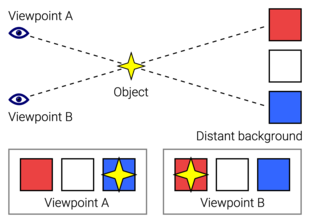
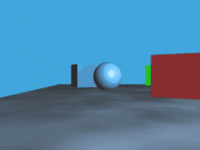
Parallax is a displacement or difference in the
, nearby objects show a larger parallax than farther objects, so parallax can be used to determine distances.To measure large distances, such as the distance of a planet or a star from Earth, astronomers use the principle of parallax. Here, the term parallax is the semi-angle of inclination between two sight-lines to the star, as observed when Earth is on opposite sides of the Sun in its orbit.[a] These distances form the lowest rung of what is called "the cosmic distance ladder", the first in a succession of methods by which astronomers determine the distances to celestial objects, serving as a basis for other distance measurements in astronomy forming the higher rungs of the ladder.
Parallax also affects optical instruments such as rifle scopes, binoculars, microscopes, and twin-lens reflex cameras that view objects from slightly different angles. Many animals, along with humans, have two eyes with overlapping visual fields that use parallax to gain depth perception; this process is known as stereopsis. In computer vision the effect is used for computer stereo vision, and there is a device called a parallax rangefinder that uses it to find the range, and in some variations also altitude to a target.
A simple everyday example of parallax can be seen in the dashboards of motor vehicles that use a needle-style mechanical speedometer. When viewed from directly in front, the speed may show exactly 60, but when viewed from the passenger seat, the needle may appear to show a slightly different speed due to the angle of viewing combined with the displacement of the needle from the plane of the numerical dial.
Visual perception
Because the eyes of humans and other animals are in different positions on the head, they present different views simultaneously. This is the basis of stereopsis, the process by which the brain exploits the parallax due to the different views from the eye to gain depth perception and estimate distances to objects.[3]
Animals also use motion parallax, in which the animals (or just the head) move to gain different viewpoints. For example,
Distance measurement

Parallax arises due to a change in viewpoint occurring due to the motion of the observer, of the observed, or both. What is essential is relative motion. By observing parallax, measuring angles, and using geometry, one can determine distance.
In astronomy, assuming the angle is small, the distance to a star (measured in
On Earth, a
Astronomy
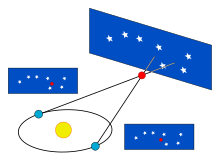

The most important fundamental
Because parallax becomes smaller for a greater stellar distance, useful distances can be measured only for stars which are near enough to have a parallax larger than a few times the
Distances can be measured within 10% as far as the


The motion of the Sun through space provides a longer baseline that will increase the accuracy of parallax measurements, known as secular parallax. For stars in the Milky Way disk, this corresponds to a mean baseline of 4 AU per year, while for halo stars the baseline is 40 AU per year. After several decades, the baseline can be orders of magnitude greater than the Earth–Sun baseline used for traditional parallax. However, secular parallax introduces a higher level of uncertainty because the relative velocity of observed stars is an additional unknown. When applied to samples of multiple stars, the uncertainty can be reduced; the uncertainty is inversely proportional to the square root of the sample size.[14]
Other individual objects can have fundamental distance estimates made for them under special circumstances. If the expansion of a gas cloud, like a supernova remnant or planetary nebula, can be observed over time, then an expansion parallax distance to that cloud can be estimated. Those measurements however suffer from uncertainties in the deviation of the object from sphericity. Binary stars which are both visual and spectroscopic binaries also can have their distance estimated by similar means, and do not suffer from the above geometric uncertainty. The common characteristic to these methods is that a measurement of angular motion is combined with a measurement of the absolute velocity (usually obtained via the Doppler effect). The distance estimate comes from computing how far the object must be to make its observed absolute velocity appear with the observed angular motion.
Expansion parallaxes in particular can give fundamental distance estimates for objects that are very far, because supernova ejecta have large expansion velocities and large sizes (compared to stars). Further, they can be observed with radio interferometers which can measure very small angular motions. These combine to provide fundamental distance estimates to supernovae in other galaxies.[15] Though valuable, such cases are quite rare, so they serve as important consistency checks on the distance ladder rather than workhorse steps by themselves.
Metrology
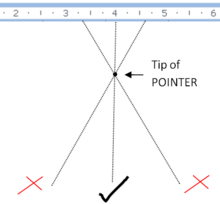
Measurements made by viewing the position of some marker relative to something to be measured are subject to parallax error if the marker is some distance away from the object of measurement and not viewed from the correct position. For example, if measuring the distance between two ticks on a line with a ruler marked on its top surface, the thickness of the ruler will separate its markings from the ticks. If viewed from a position not exactly perpendicular to the ruler, the apparent position will shift and the reading will be less accurate than the ruler is capable of.
A similar error occurs when reading the position of a pointer against a scale in an instrument such as an analog multimeter. To help the user avoid this problem, the scale is sometimes printed above a narrow strip of mirror, and the user's eye is positioned so that the pointer obscures its reflection, guaranteeing that the user's line of sight is perpendicular to the mirror and therefore to the scale. The same effect alters the speed read on a car's speedometer by a driver in front of it and a passenger off to the side, values read from a graticule, not in actual contact with the display on an oscilloscope, etc.
Photogrammetry
When viewed through a stereo viewer, aerial picture pair offers a pronounced stereo effect of landscape and buildings. High buildings appear to "keel over" in the direction away from the center of the photograph. Measurements of this parallax are used to deduce the height of the buildings, provided that flying height and baseline distances are known. This is a key component of the process of photogrammetry.
Photography
Parallax error can be seen when taking photos with many types of cameras, such as twin-lens reflex cameras and those including viewfinders (such as rangefinder cameras). In such cameras, the eye sees the subject through different optics (the viewfinder, or a second lens) than the one through which the photo is taken. As the viewfinder is often found above the lens of the camera, photos with parallax error are often slightly lower than intended, the classic example being the image of a person with their head cropped off. This problem is addressed in single-lens reflex cameras, in which the viewfinder sees through the same lens through which the photo is taken (with the aid of a movable mirror), thus avoiding parallax error.
Parallax is also an issue in image stitching, such as for panoramas.
-
Contax III rangefinder camera with macro photography setting. Because the viewfinder is on top of the lens and near the subject, goggles are fitted in front of the rangefinder and a dedicated viewfinder is installed to compensate for parallax.
-
Failed panoramic image due to the parallax, since the axis of rotation of the tripod is not the same as the focal point.
Weapon sights
Parallax affects
Optical sights
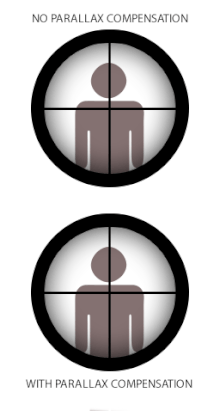
In some
Some firearm scopes are equipped with a parallax compensation mechanism, which consists of a movable optical element that enables the optical system to shift the focus of the target image at varying distances into the same optical plane of the reticle (or vice versa). Many low-tier telescopic sights may have no parallax compensation because in practice they can still perform very acceptably without eliminating parallax shift. In this case, the scope is often set fixed at a designated parallax-free distance that best suits their intended usage. Typical standard factory parallax-free distances for hunting scopes are 100 yd (or 90 m) to make them suited for hunting shots that rarely exceed 300 yd/m. Some competition and military-style scopes without parallax compensation may be adjusted to be parallax free at ranges up to 300 yd/m to make them better suited for aiming at longer ranges. [
Non-magnifying
Artillery gunfire
Because of the positioning of field or naval artillery guns, each one has a slightly different perspective of the target relative to the location of the fire-control system itself. Therefore, when aiming its guns at the target, the fire control system must compensate for parallax in order to assure that fire from each gun converges on the target.
Art
Several of Mark Renn's sculptural works play with parallax, appearing abstract until viewed from a specific angle. One such sculpture is The Darwin Gate (pictured) in Shrewsbury, England, which from a certain angle appears to form a dome, according to Historic England, in "the form of a Saxon helmet with a Norman window... inspired by features of St Mary's Church which was attended by Charles Darwin as a boy".[24]
As a metaphor
In a philosophic/geometric sense: an apparent change in the direction of an object, caused by a change in observational position that provides a new line of sight. The apparent displacement, or difference of position, of an object, as seen from two different stations, or points of view. In contemporary writing, parallax can also be the same story, or a similar story from approximately the same timeline, from one book, told from a different perspective in another book. The word and concept feature prominently in James Joyce's 1922 novel, Ulysses. Orson Scott Card also used the term when referring to Ender's Shadow as compared to Ender's Game.
The metaphor is invoked by Slovenian philosopher Slavoj Žižek in his 2006 book The Parallax View, borrowing the concept of "parallax view" from the Japanese philosopher and literary critic Kojin Karatani. Žižek notes
The philosophical twist to be added (to parallax), of course, is that the observed distance is not simply "subjective", since the same object that exists "out there" is seen from two different stances or points of view. It is rather that, as
ontological" shift in the object itself. Or—to put it in Lacanese—the subject's gaze is always already inscribed into the perceived object itself, in the guise of its "blind spot," that which is "in the object more than the object itself," the point from which the object itself returns the gaze. "Sure the picture is in my eye, but I am also in the picture"...[25]— Slavoj Žižek, The Parallax View
See also
- Binocular disparity
- Lutz–Kelker bias
- Parallax mapping, in computer graphics
- Parallax scrolling, in computer graphics
- Spectroscopic parallax
- Triangulation, wherein a point is calculated given its angles from other known points
- Trigonometry
- True range multilateration, wherein a point is calculated given its distances from other known points
- Xallarap
Notes
- ^ In the past diurnal parallax was also used to measure distances to celestial objects within the Solar System. This method has now been superseded by more accurate techniques.
References
- ^ "Parallax". Shorter Oxford English Dictionary. 1968.
Mutual inclination of two lines meeting in an angle
- ^ "Parallax". Oxford English Dictionary (Second ed.). 1989.
Astron. Apparent displacement, or difference in the apparent position, of an object, caused by an actual change (or difference) of the position of the point of observation; spec. the angular amount of such displacement or difference of position, being the angle contained between the two straight lines drawn to the object from the two different points of view and constituting a measure of the distance of the object.
- ISBN 978-0-8385-2670-5.
- ^ Steinman & Garzia 2000, p. 180.
- ^ Zeilik & Gregory 1998, p. 44.
- S2CID 18099356.
- ^
Perryman, M. A. C.; et al. (1999). "The HIPPARCOS Catalogue". Bibcode:1997A&A...323L..49P.
- ^ Harrington, J. D.; Villard, R. (10 April 2014). "NASA's Hubble Extends Stellar Tape Measure 10 Times Farther Into Space". NASA. Archived from the original on 17 February 2019. Retrieved 17 October 2014.
- ^
Riess, A. G.; Casertano, S.; Anderson, J.; MacKenty, J.; Filippenko, A. V. (2014). "Parallax Beyond a Kiloparsec from Spatially Scanning the Wide Field Camera 3 on the Hubble Space Telescope". S2CID 55928992.
- .
- ^
B., Baidyanath (2003). An Introduction to Astrophysics. PHI Learning Private Limited. ISBN 978-81-203-1121-3.
- ^ "Hubble finds Universe may be expanding faster than expected". Archived from the original on 11 September 2018. Retrieved 3 June 2016.
- ^ "Hubble stretches the stellar tape measure ten times further". ESA/Hubble Images. Archived from the original on October 30, 2017. Retrieved April 12, 2014.
- ^
Popowski, P.; Gould, A. (1998). "Mathematics of Statistical Parallax and the Local Distance Scale". arXiv:astro-ph/9703140.
- ^
Bartel, N.; et al. (1994). "The shape, expansion rate and distance of supernova 1993J from VLBI measurements". S2CID 4316734.
- ^ "Ballistic Explorer Help". www.dexadine.com. Archived from the original on 2011-09-28.
- ^ "Crossbows / Arrows & Bolts / Trajectory / Trajectories". www.crossbowmen.com. Archived from the original on 2011-07-08.
- ^ "Setting Up An Air Rifle And Telescopic Sight For Field Target – An Instruction Manual For Beginners, page 16". Retrieved 2019-10-28.
- ^ a b "Encyclopedia of Bullseye Pistol". www.bullseyepistol.com. Archived from the original on 2011-07-08.
- ^ John P. Butler (1944). "The Reflector Sight". American Rifleman. National Rifle Association. p. 31.
- ^ AFMOTGN (24 July 2008). "Aimpoint's parallax-free, double lens system... AFMO.com". Archived from the original on 2 July 2016 – via YouTube.
- ^ AR15.COM. "How Aimpoints, EOTech, And Other Parallax-Free Optics Work – AR15.COM". www.ar15.com.
{{cite web}}: CS1 maint: numeric names: authors list (link) - ^ "Gunsight – Patent 5901452 – general description of a mManginmirror system". Archived from the original on 2012-10-07.
- ^ Historic England. "Darwin Gate (1490992)". Research records (formerly PastScape). Retrieved 4 January 2020.
- ISBN 978-0-262-24051-2.
Bibliography
- Hirshfeld, Alan w. (2001). Parallax: The Race to Measure the Cosmos. New York: W.H. Freeman. ISBN 978-0-7167-3711-7.
- Whipple, Fred L. (2007). Earth Moon and Planets. Read Books. ISBN 978-1-4067-6413-0..
- Zeilik, Michael A.; Gregory, Stephan A. (1998). Introductory Astronomy & Astrophysics (4th ed.). Saunders College Publishing. ISBN 978-0-03-006228-5.
External links
- Instructions for having background images on a web page use parallax effects
- Actual parallax project measuring the distance to the moon within 2.3%
- BBC's Sky at Night program: Patrick Moore demonstrates Parallax using Cricket. (Requires RealPlayer)
- Berkeley Center for Cosmological Physics Parallax
- Parallax on an educational website, including a quick estimate of distance based on parallax using eyes and a thumb only
- . Collier's New Encyclopedia. 1921.





